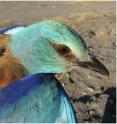Uncovered: The European roller's route between Africa and Europe
Its blue and brown-coloured plumage is undoubtedly the most distinctive feature of the European roller, a threatened migratory bird. Up until now, little was known about this bird's migration patterns and wintering. For the first time, scientists from nine countries reveal the routes between the southern part of Africa and Europe taken by a considerable part of this species which is currently in a fragile state of conservation. Researchers have been able to uncover this information with the help of geolocators and satellite transmissions. It breeds in Europe, crosses the Mediterranean via different routes, rests in Sub-Saharan Africa and winters in the southern part of Africa. Each year, the European roller (Coracias garrulus) covers close to ten thousand kilometres to breed and to winter over a route that was practically unknown up until now.
A team of scientists from nine countries (Spain, United Kingdom, Portugal, France, Austria, Switzerland, Montenegro, Lithuania and Cyprus) utilised data obtained from geolocators, satellite transmissions and bird ringing to examine the migration and wintering of this bird throughout a large part of the area where it is located. The results are published in the Diversity and Distributions journal.
Thanks to this research, scientists have been able to "uncover migration routes, resting areas and wintering grounds in addition to the degree of migratory connectivity in different populations of this species," explains Deseada Parejo to SINC, a researcher for the department of Anatomy, Cellular Biology and Zoology at the University of Extremadura (Spain) and co-author of the study.
Identifying key areas
Migration poses a significant challenge to the European roller seeing as these birds are presented with diverse threats from their breeding grounds in Europe to their wintering ones in the southern part of Africa. For this reason, the investigation "has allowed for the identification of key areas and an improved understanding of the species," indicates Parejo, who adds that this is an important factor to consider given this specie's fragile state of conservation.
As a result of the 34 specimens that were tracked, scientists were able to detect a high degree of migratory connectivity in the rollers that reproduce in Eastern Europe and low connectivity in the rollers that reproduce in the western part of the continent.
"Migratory connectivity represents the degree to which specimens from the same breeding population winter together. Thus, a high connectivity indicates that specimens from different breeding populations practically do not mix together at wintering grounds," emphasises the researcher.
Scientists consider the low connectivity of rollers from the west to be a 'positive' factor since it reduces the sensitivity of different breeding populations to local habitat losses at wintering grounds. This is the opposite of what happens with rollers from Eastern Europe that show a greater sensitivity to changes in the local habitat during the winter.
This investigation is considered to be a benchmark for animal migration studies and migratory connectivity given the large spatial area it has covered. It reveals the importance of the northern parts of the Sudanian and Sahel Savannas where these birds stop to rest. In the springtime, a return route that stands out is the one covered by the rollers that breed more towards the east around the Horn of Africa and the Arabian Peninsula.
Source: FECYT - Spanish Foundation for Science and Technology
Articles on the same topic
- Gone with the windWed, 21 Oct 2015, 15:54:41 UTC
- How wind might impact birds' migration routesTue, 20 Oct 2015, 20:03:37 UTC
Other sources
- Uncovered: European roller's route between Africa, Europefrom Science DailyTue, 20 Oct 2015, 20:00:17 UTC
- Uncovered: The engangered European roller's route between Africa and Europefrom PhysorgTue, 20 Oct 2015, 14:00:18 UTC
- How wind might impact birds' migration routesfrom PhysorgMon, 19 Oct 2015, 16:30:40 UTC
- In Photos: The Spectacular Migration of Monarch Butterfliesfrom Live ScienceSun, 18 Oct 2015, 14:30:17 UTC
